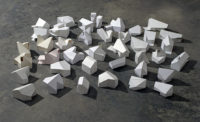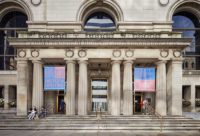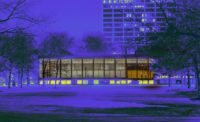Chicago Architecture Biennial Announces 2017 Curators and Theme
The showcase’s second edition, themed “Make New History” will focus on the relationship between art and architecture, and history and modernity.

Photo © Zach Mortice

Photo © Zach Mortice

Photo © Zach Mortice



After the runaway success of last year’s Chicago Architecture Biennial (CAB), organizers announced plans for the 2017 edition. At a press briefing yesterday at the Chicago Cultural Center, Mayor Rahm Emanuel and CAB officials named Los Angeles-based architects Sharon Johnston and Mark Lee of Johnston Marklee artistic directors and selected Todd Palmer, associate director and curator of the National Public Housing Museum (NPHM), as the show’s executive director. Johnston and Lee will select the international roster of participants, while Palmer will ground the show in connections to Chicago’s cultural and social life.
The 2017 theme will be “Make New History,” and, according to the curators, focus on the relationship between modernity and history, and the relationship between art and architecture. “The first [theme] is more inwardly focused within the discipline,” said Lee at a press conference yesterday, “and the second one is more outwardly focused with the different disciplines.”
Once again held in the Shepley, Rutan, and Coolidge-designed 1897 Chicago Cultural Center, the biennial will take place from September 16, 2017 to December 31, 2018. By starting the biennial one month early, it will coincide with the Expo Chicago art fair, in hopes to gain visitors from both the art and architecture worlds. Corporate sponsor SC Johnson has pledged $2.5 million so far, a hefty portion of the estimated $6.5 million budget, according to the Chicago Tribune. Like CAB 2015, admission will be free.
Last year’s biennial, themed “The State of the Art of Architecture,” was largely a broad-based survey of contemporary architecture and emerging designers. But Lee and Johnston (who participated last year) have elected to narrow the focus. “We will be interested in focusing on the most innovative approaches that are deeply rooted within the tradition of the history of architecture,” Lee explained. Johnston meanwhile said she sees art and architecture converging around “the changing nature of public space.”
By exploring the relationships between modernity and history, and art and architecture, the biennial still offers an open-ended framework for an architecture biennial, and they highlight a few implicit themes seen in last year’s biennial. Chicago artist and architect Theaster Gates was one of its star contributors, investigating the potential for community uplift through his work. Similarly, a handful of emerging designers from the University of Illinois-Chicago, carved out a unique niche at CAB 2015, by blending historicist tropes and contemporary avant-garde forms, coupled with a pop-culture-savvy critical eye.
Although based on the West Coast, Johnston and Lee are already well versed in Chicago. They’ve been traveling there almost every month for the last two years to check in on active projects. But Palmer’s leadership as executive director offers a chance to ensure the biennial retains a fundamental understanding of the city and its unique place in architectural history. His work with NPHM (which hosted a 2015 biennial satellite exhibit) puts him at the fulcrum of how design can reach Chicago communities outside the design world.
Connecting the biennial to residents, Palmer said, can demonstrate to all Chicagoans that “what happens on your block can inspire someone from half a world away.”






